|
Getting your Trinity Audio player ready...
|
Who is Satoshi Nakamoto? The pseudonymous creator of Bitcoin was a mystery to the computer science and cryptography world for many years. While Dr. Craig Wright was doxed as Bitcoin’s creator by Wired and Gizmodo in 2015, the politics of Bitcoin have muddied the waters and made a rational discussion of the facts very difficult to have with a mainstream audience. Since then, the term “Faketoshi” has become ubiquitous with anyone who makes personal claims about the muddied history of Bitcoin and Satoshi Nakamoto. This is largely because of the perverse incentives of wealth that have been created in the gray areas where the truth hasn’t shined a light, and this article aims to clarify what it means to be a Faketoshi in 2023.
The small blocker BTC crowd holds a deeply political view about the nature of the Bitcoin protocol and its governance, and therefore gives a lot of weight to candidates who agree principally with their view of permanently small blocks, UASF governance (User Activated Soft Fork), and an ethos of “code-is-law” from the cypherpunk community. While some candidates, like Dave Kleiman, have been proven in court not to have helped create Bitcoin, a great deal of populist candidates still get brought up regularly.
We previously discussed why Nick Szabo and Adam Back’s reputations as maybe being Satoshi fall apart, and how they have benefited tremendously from the ambiguity that they maintain on the subject.
In this article, we will see the exact opposite from Hal Finney: a man who has exponentially more right than Szabo or Back to take credit for early contributions to Bitcoin, yet benefited from it substantially less because of his humility and a terrible misfortune.
Everyone’s favorite
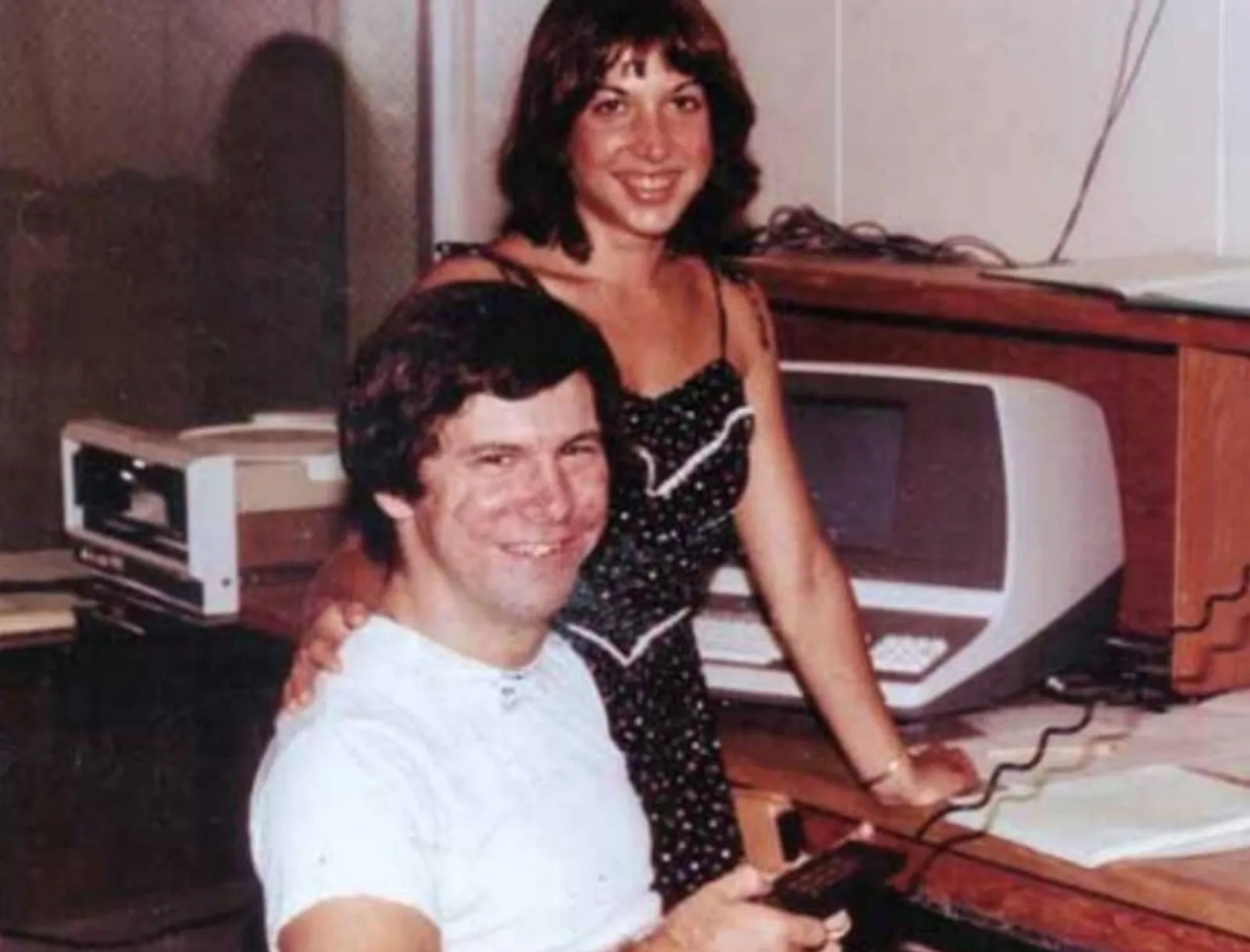
Hal Finney seems, by all accounts, to have been a very nice, kind, hard-working person. He was a universally well-liked member of the Bitcoin community from week one, and he fit the profile of what the earliest bitcoiners assumed Satoshi Nakamoto should have looked like. In fact, the more a good man reads about Hal Finney, the more a good man should be inspired to be a good man too!
He was a politically minded, but non-combative libertarian, a cypherpunk activist, member of various cryptography and cypherpunk forums and mailing lists, and he was an avid coder with big opinions about digital cash and cryptography. He was also probably the second miner on the network—joining at some point in the block height between 70-80 and announcing it on twitter with the first Bitcoin tweet in history.
Running bitcoin
— halfin (@halfin) January 11, 2009
Hal even worked in commercial applications of public key cryptography at PGP Corporation, and he may have been the first person to ever implement a proof of work system in his “Reusabal Proofs of Work” or “RPOW” application noting its potential usefulness in digital cash or in fighting against email SPAM.

But Hal wasn’t Satoshi
While Finney was absolutely involved in the earliest public days of bitcoin and deserves credit for being a great believer in the system and a confidant to Satoshi, a little bit of digging makes it pretty clear that he could not have been Satoshi Nakamoto, the creator of bitcoin.
Windows, Mac, Linux.
We know Satoshi Nakamoto was a Windows user. A borderline exclusive Windows user, which is a major point that made Nakamoto stand out as an anomaly in the coding world where Mac and Linux systems are more common.
For example, Nakamoto asked Laszlo Hanyecz to code up Bitcoin on MacOS because he didn’t even have a Mac to work on.
According to Hanyecz, “Bitcoin originally didn’t work on Mac. So I ported it to that. Satoshi actually asked me to do the releases for MacOS. I would do the build because he didn’t have a Macintosh. He didn’t know how to build it for Mac. So I was doing that and it was actually my binaries that were being posted.”
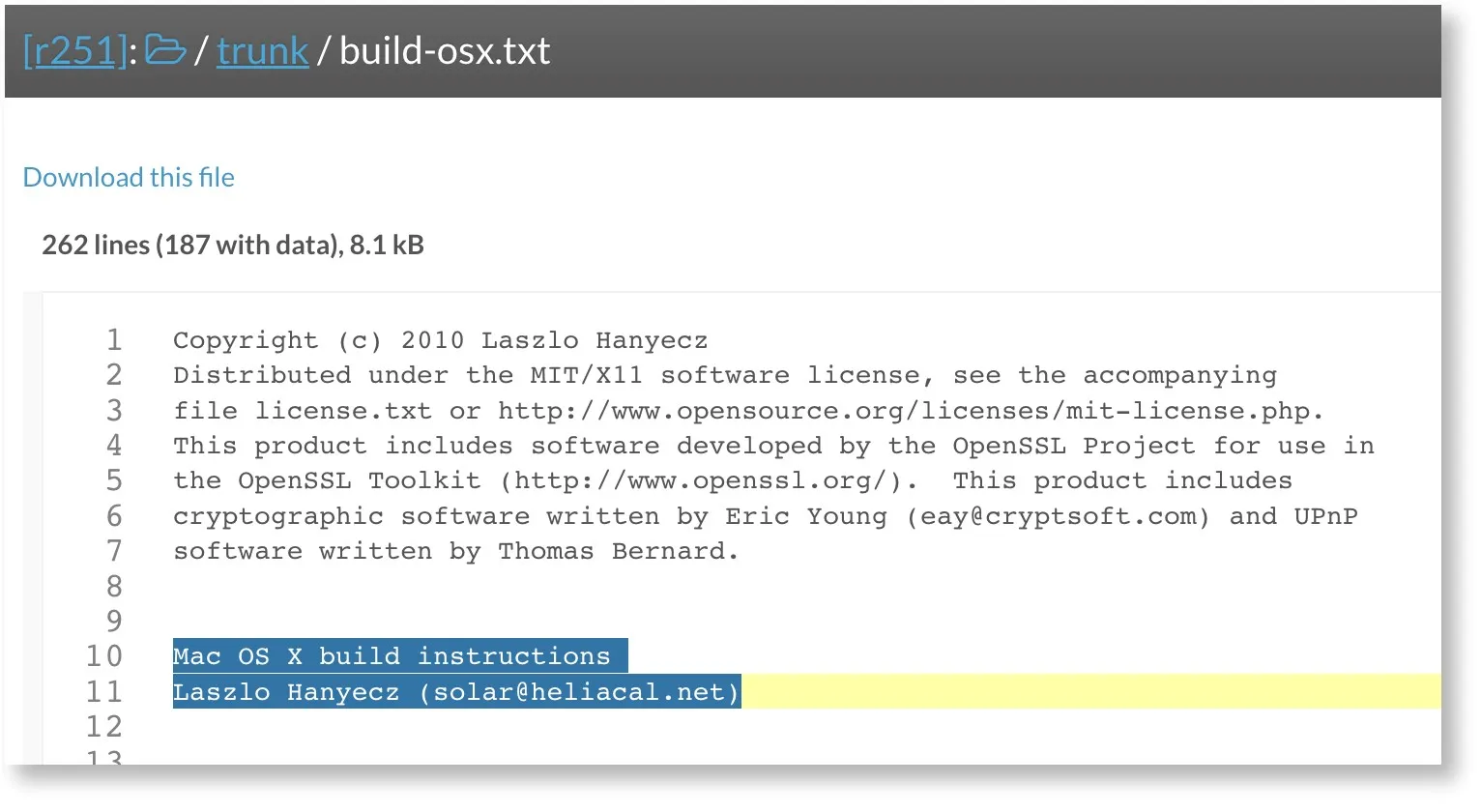
However, we know Hal Finney was a Mac user, as he tweeted about it, explained how to use PGP work-arounds on Mac systems and was comfortable speaking about working in Mac environments.
Going to Google calendar page causes an infinite loop of redirects for both my wife's and my Macs. Google status page says AOK?
— halfin (@halfin) June 9, 2010
Bitcoin isn’t crypto
Satoshi Nakamoto was also heavily presumed not to be a professional coder or cryptographer. Notably, Nakamoto used elliptic curve secp256k1 which is a very particularly uncommon curve. Most professional cryptographers would have chosen a curve that confirmed to NIST standards. When asked about it by Hanyecz, Nakamoto was said to say, “I had a bunch of people look at it, and they told me this was good,” according to a 2020 interview with Cointelegraph. This is a very bizarre way to pick an elliptical curve to secure the system if one understood cryptography.
Gavin Andresen, Bitcoin’s second lead maintainer, once called Nakamoto’s use of SSL “kind of naive” and also criticized his lack of documentation for things like Schnorr or Lamport signatures, which would have been standard practice for a cryptographer even if they weren’t used.
Andresen also pointed out the amateurity of Nakamoto’s quote on the topic of cryptography in Bitcoin.

Andresen closed saying, “But key blinding and group signatures are concepts from Crypto 101… Satoshi was a brilliant programmer, but he didn’t have a deep understanding of all the cutting edge crypto research that’s going on.”
Peter Todd also mentions Satoshi’s lack of cryptography chops on Reddit saying, “He made many design decisions that suggest he wasn’t a ‘professional’ cryptographer… the fact that the defender in the Bitcoin system only has a linear advantage over the attacker, rather than an exponential one, really runs contrary to how cryptographic systems are designed, yet in the case of Bitcoin social and economic factors make such a system work anyway; that’s the kind of idea that often takes an outsider with a fresh perspective…”
But rather than being some kind of amateur, naive outsider to crypto, Hal Finney was a highly credentialled cryptographer at the cutting edge of crypto technology. In fact, he was hired by the legendary Phil Zimmerman at PGP and Finney coded up the benchmark PGP 2.0 implementation, which is widely regarded as the first great implementation of the technology in the world, and he stayed at the head of the field until retirement.
He was a leading expert in cryptography such that he was cited by other cryptographers in their white papers about cryptography. Daniel Bleichenbacher of Bell Labs cited Finney specifically for his expertise on SSL in his 1998 white paper, “Chosen Ciphertext Attacks Against Protocols Based on the RSA Encryption Standard PKCS #1,” while folks like Andresen criticized the amateurish nature of Nakamoto’s use of SSL.

Finney notably won challenges to break Netscape’s SSL encryption “in short order,” as he put it. So, Finney was at the forefront of his field in cryptography throughout the Bitcoin years when Satoshi Nakamoto was making amateurish decisions and statements about the use of cryptography and SSL implementations. This doesn’t make sense if Finney was Nakamoto.
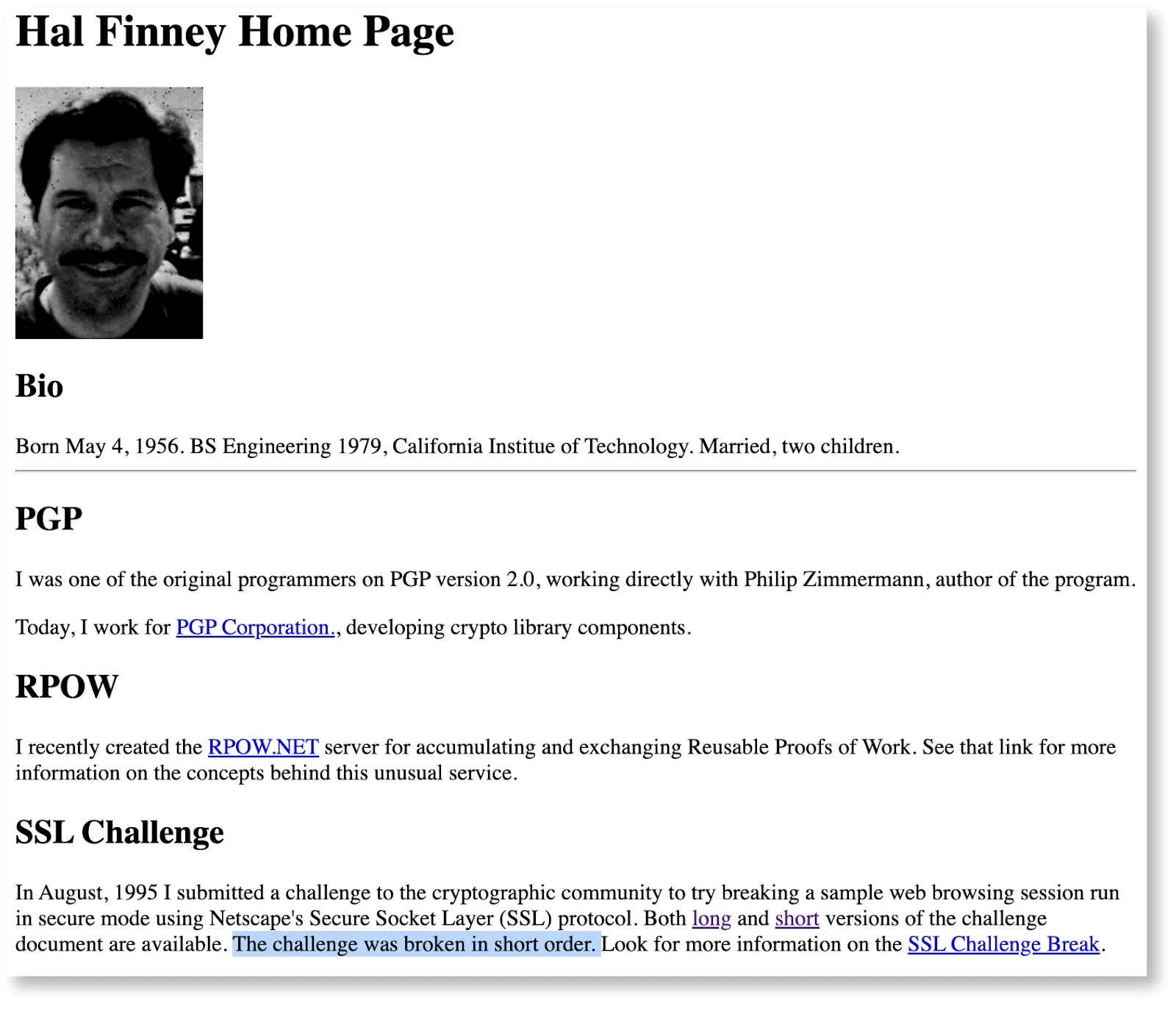
Furthermore, Hal had disagreements with Nakamoto’s implementation security on more than one occasion, and (with a nod to his crypto sensibilities) disliked the privacy model of bitcoin as Satoshi envisioned it.
Looking at ways to add more anonymity to bitcoin
— halfin (@halfin) January 21, 2009
Coding abilities and style
Satoshi Nakamoto had a unique coding style with peculiar grammar in the C++ language, which is a powerful, object-oriented language built as an extension of the “C” programming language. C uses similar rules, but is ultimately a more rigid language used for system applications and low-level programming applications.
By contrast, Finney was a C programmer with limited experience in C++, and his contributions to bitcoin were heavily weighted to code and security auditing of what Nakamoto had created. In Finney’s own words to journalist Andy Greenberg, he explains the difference in their coding styles.
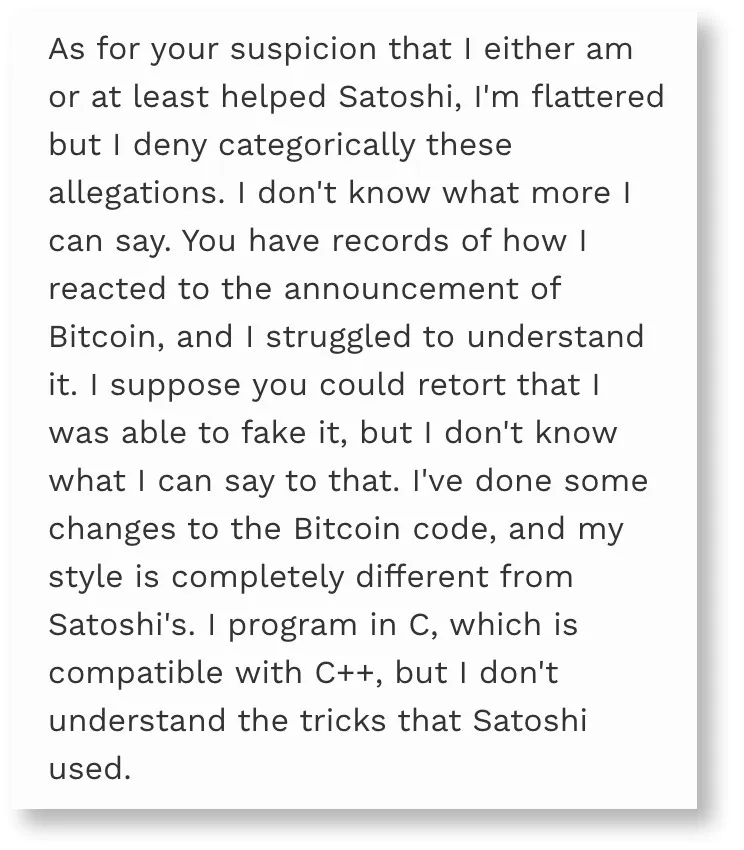
Security
In a security audit, a coder is not supposed to audit their own work. Their own edits should have already been done before handing over for an audit, and this is what Nakamoto did with Finney: he handed over the code for a third party audit. Finney and Nakamoto were both experts in security practices, so they would not have skipped this or faked it. And we are blessed that their private emails have been made public by Finney’s wife and son, Fran and Jason Finney.
It’s also important to note that Ray “Bear” Dillinger was also involved to some degree in these audits and early feedback sessions, and the three of them communicated together, which is a tough charade to manage both in written word and in code syntax. If we are to believe that Finney was pretending to be Nakamoto while also being himself in this complex process, we are asking a lot of the man!
According to Dillinger, “Hal and I were essentially giving it a last-minute looking over to see if we thought there was any way to attack it” in November 2008. The code is still available on BitcoinTalk.
In this era of Bitcoin, the pre-release and version 0.1 was replaced by new versions very quickly because of Finney’s expert reporting and debugging.
An example from Finney to Nakamoto:

And Nakamoto’s response:
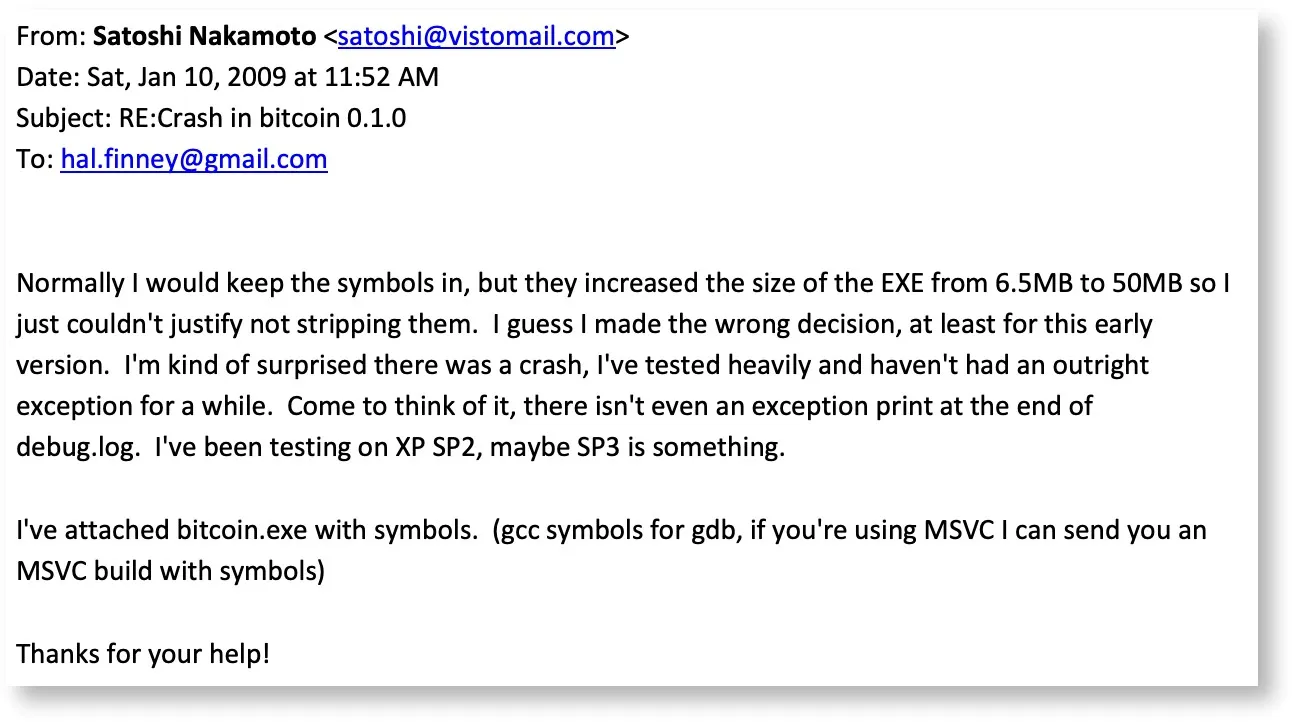
The above conversation went back and forth working out several bugs that was crashing Bitcoin and led to versions 0.1.2 and 0.1.3 in order to get it running as expected. Again, this is peculiar behavior to simulate in private emails, if we are assuming it was a ruse put on by Finney.
It is also crucial to reiterate the danger of not having a third party audit of financial code, so it is unlikely that Finney could be Nakamoto and juggled the task of a complex charade while also successfully completing the audit and releasing the code.
Worldview differences
Similarly in the evidence published against Szabo, Finney has fundamental disagreements with Nakamoto on the implementation, purpose and use of Bitcoin. Finney also seemed to think Nakamoto and his invention were cavalier, insecure and generally flawed on both technical and philosophical points.
Notably, Finney did not like the concept of competitive mining, excessive emissions of the mining process or a number of things about the competitive game theory of the system. In fact, he seems to have wanted miners to be altruistic for social value—at least in theory.

Satoshi’s response is curiously obtuse. Is he saying the libertarian viewpoint is in harmoney with Finney’s thoughts? In my opinion, this is a contrasting retort. Libertarians are fiercely competitive, so it can perhaps be assumed that Nakamoto is saying that competition is the attractive part. That is what I have always assumed on this point.

This is reinforced by Nakamoto’s advocacy for Bitcoin to move into server farms with specialized hardware. He clearly saw the need for industrialization of nodes and hashing, which would infer that the “libertarian” comment meant the opposite of “home compute… volunteer… for good causes.”

Finney also clearly worried about the environmental impact of mining at scale which shows Finney was concerned about “problems” created by industrialization.
Thinking about how to reduce CO2 emissions from a widespread Bitcoin implementation
— halfin (@halfin) January 27, 2009
This is in deep contrast to the view of Nakamoto who predicted and advocated for large scale specialization and industrialization!
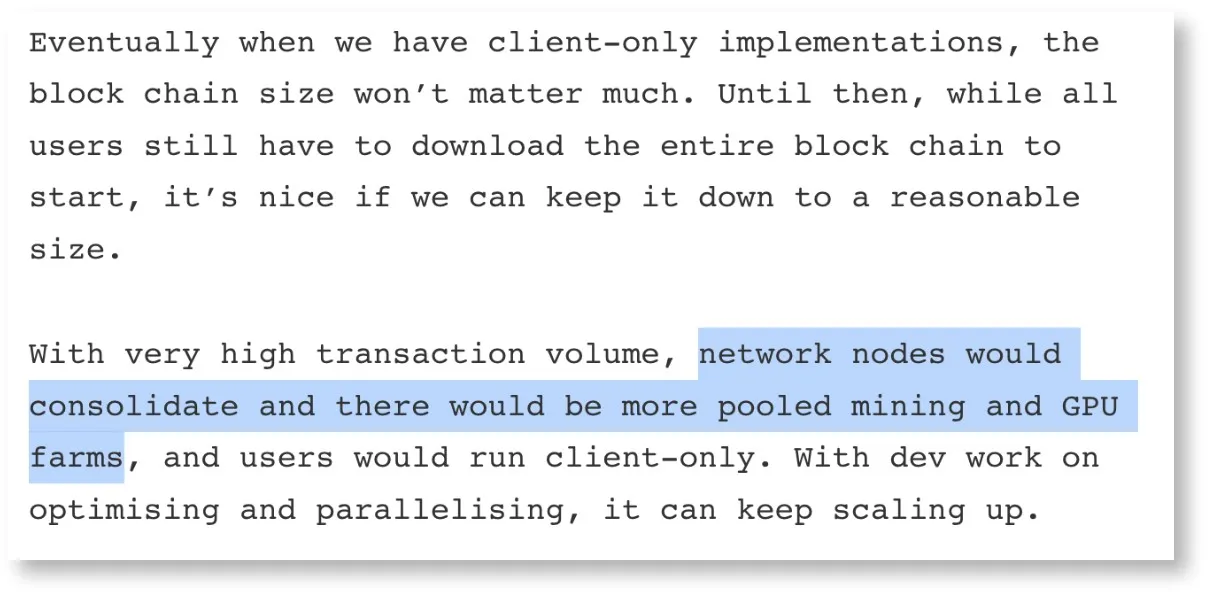
According to Dillinger, Finney also introduced the concept of a block size limit. Being primarily concerned with security over usability, Finney saw the risks of a DoS attack on Bitcoin unless there was a consensus level throttle.

This is in contrast to Nakamoto’s position on node consolidation and his view that Bitcoin was meant to scale past Visa “with existing hardware” in his early communications with Mike Hearn. This would require massive block size!

He also believed that Bitcoin’s purpose was to process as many transactions as possible with nodes competing to be the best at processing the most transactions as efficiently as possible.

Lastly, Nakamoto AGAIN predicted GPU cards and specialization explaining that Bitcoin is only vulnerable “when it’s small.”

Conclusion
Hal Finney deserves an incredible amount of gratitude and credit for his contributions to bitcoin, but it’s clear that he was not Satoshi Nakamoto. He disagreed with major parts of the design and the implementation. He also wasn’t prone to sock puppetry or any of the qualities one might expect from someone trying to play both sides an identity con. Lastly, he vehemently denied that he was bitcoin’s creator multiple times in his life, and based on his general sincerity, I believe him.
To believe that Hal Finney was Satoshi Nakamoto is to believe that the details in his heartfelt farewell note to the Bitcoin community were a lie. I don’t believe Hal Finney was a liar or had a dishonest bone in his body, and it would be a disservice to his legacy to conclude otherwise.
Hal was proud to receive 10 bitcoins from Satoshi Nakamoto. His son Jason shared a screenshot with Andy Greenberg showing them in his wallet.

And he was proud to “the first person besides Satoshi to run bitcoin.”
In his farewell, he continued with pride, “I mined block 70-something, and I was the recipient of the first bitcoin transaction, when Satoshi sent ten coins to me as a test. I carried on an email conversation with Satoshi over the next few days, mostly me reporting bugs and him fixing them.”
And Hal Finney closed with: “I’m comfortable with my legacy.”
And what a legacy!
Hal Finney was a seasoned distance runner, and a happily married father of two. The neuro-muscular disease ALS slowly changed Finney from a man of incredible strength, and it reduced him to complete paralysis before his untimely death.

Through it all, he remained upbeat, optimistic and dedicated to his family and his work. He cared about his children and the legacy that he would leave as a security innovator, free thinker, contributor to Bitcoin and a friend to Satoshi Nakamoto.
In his last days and for some time after his death in 2014, criminal extortionists made the life of the Finneys unpleasant with threats and cyber attacks against their family—an awful consequence of the culture of Bitcoin becoming so deeply toxic, so let us remember to defend the weak and to always be good to each other.

If you would like to donate to research to find a cure for ALS, the disease that took Hal’s life, watch the video.
Watch: Fran Finney for the 2023 Running Bitcoin Challenge

 09-17-2025
09-17-2025 






